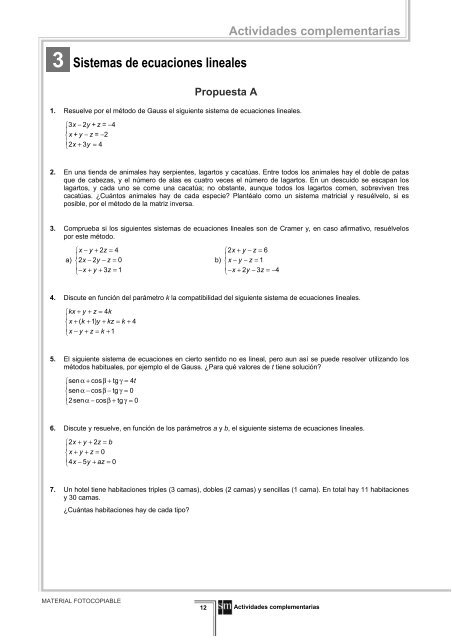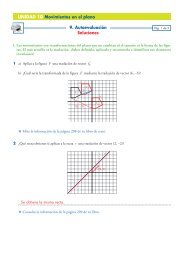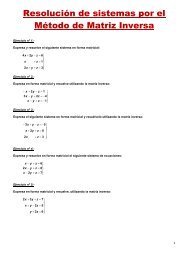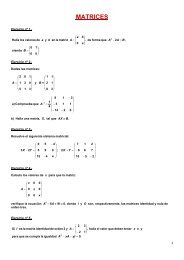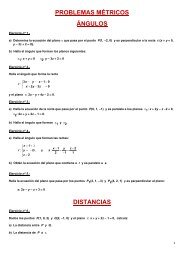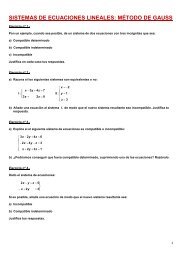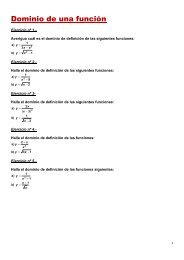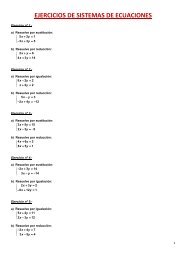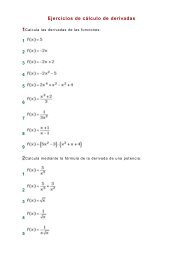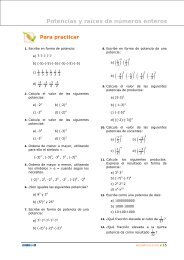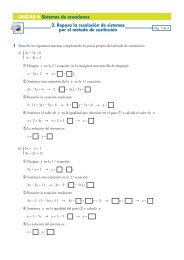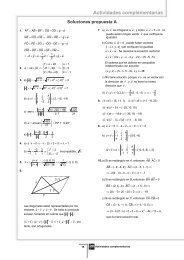3 Sistemas de ecuaciones lineales - Amolasmates
3 Sistemas de ecuaciones lineales - Amolasmates
3 Sistemas de ecuaciones lineales - Amolasmates
You also want an ePaper? Increase the reach of your titles
YUMPU automatically turns print PDFs into web optimized ePapers that Google loves.
3 <strong>Sistemas</strong> <strong>de</strong> <strong>ecuaciones</strong> <strong>lineales</strong><br />
Propuesta A<br />
1. Resuelve por el método <strong>de</strong> Gauss el siguiente sistema <strong>de</strong> <strong>ecuaciones</strong> <strong>lineales</strong>.<br />
3x<br />
−2y+z= −4<br />
<br />
x+y<br />
−z= −2<br />
<br />
2x<br />
+ 3y = 4<br />
12<br />
Activida<strong>de</strong>s complementarias<br />
2. En una tienda <strong>de</strong> animales hay serpientes, lagartos y cacatúas. Entre todos los animales hay el doble <strong>de</strong> patas<br />
que <strong>de</strong> cabezas, y el número <strong>de</strong> alas es cuatro veces el número <strong>de</strong> lagartos. En un <strong>de</strong>scuido se escapan los<br />
lagartos, y cada uno se come una cacatúa; no obstante, aunque todos los lagartos comen, sobreviven tres<br />
cacatúas. ¿Cuántos animales hay <strong>de</strong> cada especie? Plantéalo como un sistema matricial y resuélvelo, si es<br />
posible, por el método <strong>de</strong> la matriz inversa.<br />
3. Comprueba si los siguientes sistemas <strong>de</strong> <strong>ecuaciones</strong> <strong>lineales</strong> son <strong>de</strong> Cramer y, en caso afirmativo, resuélvelos<br />
por este método.<br />
x−<br />
y + 2z = 4<br />
<br />
a) 2x−2y<br />
− z = 0<br />
<br />
−<br />
x+ y + 3z = 1<br />
2x<br />
+ y − z = 6<br />
<br />
b) x−y<br />
− z = 1<br />
<br />
−<br />
x+ 2y − 3z = −4<br />
4. Discute en función <strong>de</strong>l parámetro k la compatibilidad <strong>de</strong>l siguiente sistema <strong>de</strong> <strong>ecuaciones</strong> <strong>lineales</strong>.<br />
kx<br />
+ y + z = 4k<br />
<br />
x+<br />
( k + 1) y + kz = k + 4<br />
<br />
x−<br />
y + z = k + 1<br />
5. El siguiente sistema <strong>de</strong> <strong>ecuaciones</strong> en cierto sentido no es lineal, pero aun así se pue<strong>de</strong> resolver utilizando los<br />
métodos habituales, por ejemplo el <strong>de</strong> Gauss. ¿Para qué valores <strong>de</strong> t tiene solución?<br />
senα+<br />
cosβ+ tg γ= 4t<br />
<br />
senα−cosβ−tg<br />
γ= 0<br />
<br />
2senα−cosβ<br />
+ tgγ = 0<br />
6. Discute y resuelve, en función <strong>de</strong> los parámetros a y b, el siguiente sistema <strong>de</strong> <strong>ecuaciones</strong> <strong>lineales</strong>.<br />
2x+<br />
y + 2z<br />
= b<br />
<br />
x+<br />
y + z = 0<br />
<br />
4x<br />
− 5y + az = 0<br />
7. Un hotel tiene habitaciones triples (3 camas), dobles (2 camas) y sencillas (1 cama). En total hay 11 habitaciones<br />
y 30 camas.<br />
¿Cuántas habitaciones hay <strong>de</strong> cada tipo?<br />
MATERIAL FOTOCOPIABLE<br />
Activida<strong>de</strong>s complementarias
Activida<strong>de</strong>s complementarias<br />
Propuesta B<br />
1. Resuelve por el método <strong>de</strong> Gauss el siguiente sistema <strong>de</strong> <strong>ecuaciones</strong> <strong>lineales</strong>.<br />
x−2y<br />
− z = −5<br />
<br />
2x+<br />
y + 3z = 10<br />
<br />
−<br />
3x + y − z = −1<br />
2. El sistema <strong>de</strong> <strong>ecuaciones</strong> representado por la siguiente ecuación matricial tiene un número infinito <strong>de</strong> soluciones.<br />
Halla el valor <strong>de</strong> k.<br />
2 −1 −9x<br />
7 1 2 3 y = 1 2 1 −3z<br />
k <br />
3. Comprueba si los siguientes sistemas <strong>de</strong> <strong>ecuaciones</strong> <strong>lineales</strong> son <strong>de</strong> Cramer y, en caso afirmativo, resuélvelos<br />
por este método.<br />
x+<br />
y + z = 4<br />
<br />
a) x−2y<br />
− z = −1<br />
<br />
3x+<br />
2y − 4z = 4<br />
3x−<br />
y + 2z = 3<br />
<br />
b) 2x+<br />
y + 2z = 3<br />
<br />
4x−<br />
3y + 2x = 3<br />
13<br />
x+<br />
2y + 3z = 1<br />
<br />
x+<br />
3y − z = 4<br />
c) <br />
x+<br />
3y + z = 2<br />
x+<br />
2y + 4z = 0<br />
4. Halla el valor <strong>de</strong> a para que el siguiente sistema <strong>de</strong> <strong>ecuaciones</strong> no tenga una solución única.<br />
4x<br />
− y + 2z = 1<br />
<br />
2x+ 3y = −6<br />
<br />
7<br />
x− 2y<br />
+ az =<br />
<br />
2<br />
5. Halla todos los valores <strong>de</strong> k para los cuales el siguiente sistema <strong>de</strong> <strong>ecuaciones</strong> tiene soluciones diferentes <strong>de</strong> la<br />
trivial, es <strong>de</strong>cir, (0, 0, 0); y calcula en función <strong>de</strong> k el conjunto <strong>de</strong> soluciones.<br />
x−<br />
y + kz = 0<br />
<br />
kx<br />
+ 2y− 4z= 0<br />
<br />
x−<br />
y + z = 0<br />
6. Discute y resuelve el siguiente sistema <strong>de</strong> <strong>ecuaciones</strong> <strong>lineales</strong>.<br />
ax + y + z = 1<br />
<br />
x+<br />
ay + z = 1<br />
<br />
x+<br />
y + az = a<br />
2<br />
7. En un cine los titulares <strong>de</strong> carnet joven pagan 5,50 € por la entrada, los mayores <strong>de</strong> 65 años pagan 6,00 €, y el<br />
resto <strong>de</strong> espectadores, 7,50 €.<br />
En una sesión se ven<strong>de</strong>n 500 entradas y se recaudan 3600 €.<br />
Sabiendo que a esa sesión acudieron la mitad <strong>de</strong> jóvenes que <strong>de</strong> personas mayores <strong>de</strong> 65 años, ¿cuántos<br />
espectadores <strong>de</strong> cada tipo había?<br />
MATERIAL FOTOCOPIABLE


